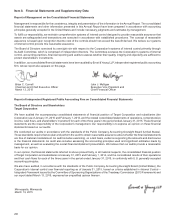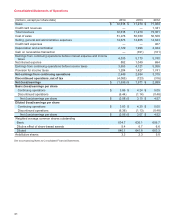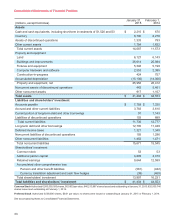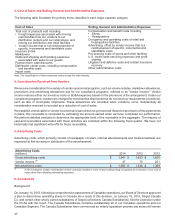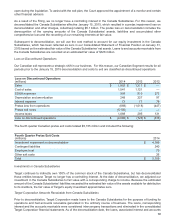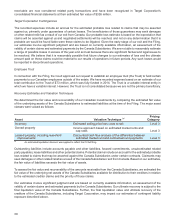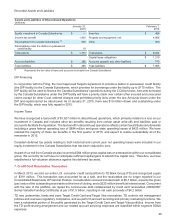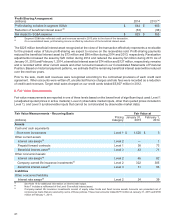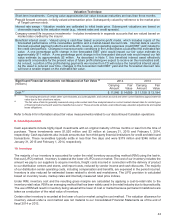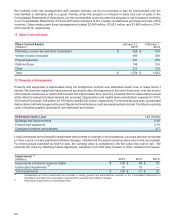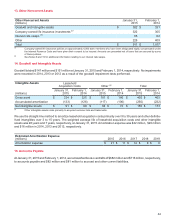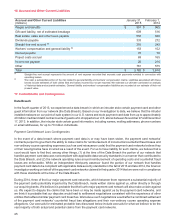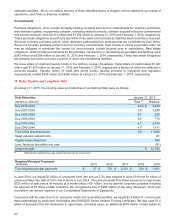Target 2014 Annual Report Download - page 44
Download and view the complete annual report
Please find page 44 of the 2014 Target annual report below. You can navigate through the pages in the report by either clicking on the pages listed below, or by using the keyword search tool below to find specific information within the annual report.
receivable are now considered related party transactions and have been recognized in Target Corporation's
consolidated financial statements at their estimated fair value of $326 million.
Target Corporation Contingencies
The recorded expenses include an accrual for the estimated probable loss related to claims that may be asserted
against us, primarily under guarantees of certain leases. The beneficiaries of those guarantees may seek damages
or other related relief as a result of our exit from Canada. Our probable loss estimate is based on the expectation that
claims will be asserted against us and negotiated settlements will be reached, and not on any determination that it is
probable we would be found liable were these claims to be litigated. Given the early stage of our exit and the Filing,
our estimates involve significant judgment and are based on currently available information, an assessment of the
validity of certain claims and estimated payments by the Canada Subsidiaries. We are not able to reasonably estimate
a range of possible losses in excess of the year-end accrual because there are significant factual and legal issues to
be resolved. We believe that it is reasonably possible that future changes to our estimates of loss and the ultimate
amount paid on these claims could be material to our results of operations in future periods. Any such losses would
be reported in discontinued operations.
Employee Trust
In connection with the Filing, the Court approved our request to establish an employee trust (the Trust) to fund certain
payments to our Canadian employees outside of the estate. We have recorded expense based on an estimate of our
total contribution to the Trust of $73 million, which was fully funded in 2014. The Trust is a variable interest entity in
which we have a variable interest. However, the Trust is not consolidated because we are not the primary beneficiary.
Recovery Estimates and Valuation Techniques
We determined the fair value and recoverability of our Canadian investments by comparing the estimated fair value
of the underlying assets of the Canada Subsidiaries to estimated liabilities at the time of the Filing. The major asset
classes were valued as follows:
Asset Valuation Technique (a) Pricing
Category
Inventory Estimated selling price less costs to sell Level 3
Owned property Income approach based on estimated market rents and
cap rates Level 3
Leased property, including leasehold
improvements
Discounted cash flow analysis of the differential between
estimated market rent and contractual rent payments Level 3
(a) An estimated liquidation discount was applied to reflect the CCAA filing.
Outstanding liabilities include accounts payable and other liabilities, forward commitments, unsubordinated related
party payables, lease liabilities and other potential claims. Potential claims include an accrual for the estimated probable
loss related to claims that may be asserted against the Canada Subsidiaries under certain contracts. Claimants may
seek damages or other related relief as a result of the Canada Subsidiaries' exit from Canada. Based on our estimates,
the fair value of liabilities exceeds the fair value of assets.
To assess the fair value and recoverability of the amounts receivable from the Canada Subsidiaries, we estimated the
fair value of the underlying net assets of the Canada Subsidiaries available for distribution to their creditors in relation
to the estimated creditor claims and the priority of those claims.
Our estimates involve significant judgment and are based on currently available information, an assessment of the
validity of certain claims and estimated payments by the Canada Subsidiaries. Our ultimate recovery is subject to the
final liquidation value of the Canada Subsidiaries. Further, the final liquidation value and ultimate recovery of the
creditors of the Canada Subsidiaries, including Target Corporation, may impact our estimates of contingent liability
exposure described above.
39


